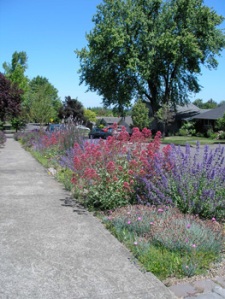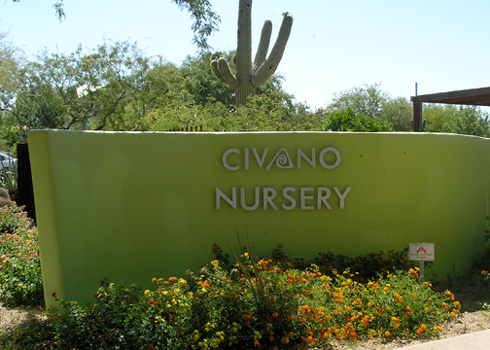Giving Native Plants A Second Look
I have become more and more intrigued with gardens designed with native plants. You may be thinking, native plants are messy and boring. The appeal is not necessarily in their showy flowers, although some have very unique flowers and textures, but in their ability to thrive in natural conditions with minimal care. I am not a purist by any means but integrating natives into your mixed borders just makes sense to me.
My goal is to visit at least one local nursery that specializes in native plants every time I travel. Business trips are much more difficult since we hardly see the light of day. On a recent trip to Tucson, Arizona, I visited my first native plant nursery, Civano Nursery.
About Civano Nursery
Civano Nusery is situated at the entrance of the Civano Development, a sustainable housing community on the Southeast side of Tucson. I was in search of a local nursery that specializes in Arizona and Sonoran Desert native plants. This had to be one of the most colorful nurseries I have ever visited. Although, I shouldn’t be surprised since most desert themes are very rich in color.
The staff were super friendly and took the time to educate me on some of the Arizona natives. A few of my favorites were the desert willow, “octopus” agave, and ocotillo. Ocotillo is a very distinctive desert shrub with thorny spikes that rise out of the ground up to 15 feet tall. During the drought season, this shrub looks dead, but once the rain hits, green leaves suddenly appear and bright, red tubular flowers appear in the spring. The nursery used the ocotillo poles as fencing to keep the rabbits out of the garden. >>More Civano Nursery plant pics
Why Plant With Natives?
 Most everyone is attracted to flowering plants. No one seems to notice the unassuming Viburnum that screens the ugly water faucet I installed. Instead, people tend to notice One-ear Eddie, the gargoyle that sits on top of the post that supports the water faucet. I’m not suggesting everyone get rid of their herbaceous perennials, but simply integrate both native and non-native species. Natives attract more beneficial insects than non-natives and are less invasive than many exotics. Desert regions greatly benefit from the use of native plants since water is more scarce than in other parts of the country.
Most everyone is attracted to flowering plants. No one seems to notice the unassuming Viburnum that screens the ugly water faucet I installed. Instead, people tend to notice One-ear Eddie, the gargoyle that sits on top of the post that supports the water faucet. I’m not suggesting everyone get rid of their herbaceous perennials, but simply integrate both native and non-native species. Natives attract more beneficial insects than non-natives and are less invasive than many exotics. Desert regions greatly benefit from the use of native plants since water is more scarce than in other parts of the country.
In the West, many gardens can have a variety of habitats in their yards, including desert, chaparral, woodland, wetland, and prairie. Take my garden for example, I have a combination of desert, meadow and woodland. I used to have wetlands all over my backyard until I dug in, I don’t know how many, french-drains and shoveled in tons of dirt to make raised beds. The 4 by 40 foot parking strip gets barely any hand-watering and lots of sun, so I planted drought-tolerant perennials. My favorite is Catmint ‘Walker’s Low’ (see photo) and the bees love it too. Plant combos in the shady, woodland part of my garden include Sweet Woodruff, Astibles, Japanese Forrest Grass, and our native Deerfern.
What do you mean by “established?”
This term used to puzzle me when I first started gardening, and yes, I knowingly admit I was very ignorant. I would read, “once you establish you plants you won’t need supplemental watering” and think, “what in the world is that supposed to mean?” You see this term used all the time when describing the benefits of xeriscape or drought-tolerant plants. By the way, drought-tolerant DOES NOT mean “no water necessary.” You first have to establish your newly bought container plants and help them acclimate to their new surroundings. This term is important to understand since it’s the biggest benefit to planting with natives.
Assuming you have sited right the location and conditions, saturate the soil with water immediately after planting. This is best done with a soaker hose or drip system as opposed to over-head watering (watering the plant leaves instead of just the roots). For the next 1 or 2 summers, water the plant steadily, being careful not to let them dry out completely, but don’t over soak them either. This is why I suggest a soaker hose, less time spent standing over your plants and easier to apply a constant amount of water. After the first couple of years getting your plants “established”, you will need little supplemental watering.
Native Plant Inspiration and Resources
- >>Santa Barbara Garden by Isabelle Greene
- >>Meadow designs by Piet Oudolf
- Search Plant Native for plants, nurseries, and books by region
- >>Arizona Native Plant Society



Hi Jayme, I think it is a good idea to integrate native plants into the garden. Many native plants have survived that way. Here in Australia most gardens have native plants, somtimes they consist of nothing else. I am not such a purist and like all sorts of exotics too.
@Trudi:
Long time no speak. Hope you are well. Thanks for the visit and the thoughtful comments. I’m not a purist either and lucky the growing conditions here support many different plants. Plenty of rain here.
Happy Winter!